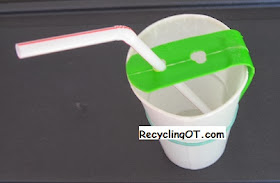
Source: Sensory Pull Activity for Children with Autism or Sensory Processing Disorders by RecyclingOT
This is one of the easiest therapy tools I have ever designed and made and I love it because i can use it in numerous ways. Its also small, light and quick to make out of detergent bottle handles and a strip of fabric. Simply cut the handles as shown int he photos. Thread the fabric through the center handle (white in the photo) and tie ends to the other two bottles (green and red in the photo) .
If your goal is to develop a palmar grasp present the handle to the person and help him to gasp and pull while you hold the white center handle. The person will experience the immediate success of pulling so that the fabric moves a short distance. This works very well in a small group activity where you take turns moving from one individual to the next. The children (or adults) have minimal demands placed on them since their turn is brief and they get to watch others have their turns.
I have used this
activity while children are sitting on a horse facingforwards,
sideways or backwards and while kneeling and standing on top of the
horse. I have incorporated pulling the handles while they do sit-ups and while prone-moving into prone extension. You can do similar
reaching activities that challenge the person's postural control using a
swing or bolster.
Pulling
hard on anything provides proprioceptive stimulation to muscles and
joints. I discovered that some individuals are quite strong and can pull
to the point of ripping the fabric. So I have used extra wide and
strong materials to use this in an activity between older individuals who
benefit from pulling hard while at the same time following my
directions to let go of their handle (i.e. red) while the other person takes a turn
pulling (i.e. green handle). This set-up promotes social skills !
One of
the videos shows a client swinging on a hammock in a sensory room. He learned to
maintain his grasp while I pulled hard enough to move the swing.
I
also reinforce directionality concepts when I tell clients to pull
upward or downward, left or right, even diagonally. Then I position the
handle so that they don't have an option other than to follow my
directions.If you have enjoyed this post-please share my website, courses, books and toys on your blogs and Facebook pages................
https://www.facebook.com/pages/The-Recycling-Occupational-Therapist/113805848640610?ref=hl















































